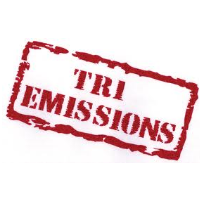State Toxic Releases Climbed 50%, Mostly Because of One Waste Disposal Facility

Around 82% of California’s releases of toxic materials into the environment in 2013 occurred at a single hazardous waste facility and was the greatest contributor to a 50% increase in emissions over the year before, according to an annual report from the U.S. Environmental Protection Agency (EPA).
The EPA's Toxics Release Inventory (TRI), using data gathered from 1,263 California facilities, calculated that 47.61 million pounds of toxic chemicals were released in 2013. Data was gathered by mid-2014 and published at the beginning of this year. It covers releases on land, on water and in the air. Nationwide, toxic releases rose 15%, thanks to mining interests.
Clean Harbors Buttonwillow LLC in Kern County, as usual, was the clear California leader thanks to an abundance of copper waste. The commercial hazardous waste storage, treatment and disposal facility near Bakersfield released about 10 times more toxics than the runner-up Mesquite Mine.
Mesquite is one of the world’s largest gold mines and is operated by New Gold near the city of Glasmis in Imperial County. But if you take Mesquite’s lead compounds out of the mix, Buttonwillow materials occupy the other seven top spots, including landfill releases of arsenic and asbestos.
The EPA ranked California 41st out of 56 states and territories for total releases per square mile (#1 is the worst). The state only accounted for about 1% of the nation’s total. But Buttonwillow’s 26.9 million pounds of gunk nearly equaled the state’s entire total of 31.8 million pounds the year before.
Many of the releases from TRI facilities are regulated under various EPA programs and are not illegal. That prompted Clean Harbors' senior vice president for compliance Phillip Retallick to complain to the Los Angeles Times that it was unfair to call the stuff legally dumped at the Buttonwillow landfill a toxic release.
Point taken, but cataloguing legal releases still gives a heads-up to neighbors and other interested parties about toxic activities which may be legal but not necessarily OK. For instance, EPA administrator Jared Blumenfeld expressed interest, to the Times, about the huge increase in copper waste at Buttonwillow, which had gone undetected until now. “It does pique our interest, and certainly where we see big spikes it helps target our enforcement actions,” he said.
The Top 10 facilities in California for 2013 based on total releases (in pounds) of toxic materials were:
| Company | City | County | Total Releases |
| Clean Harbors Buttonwillow LLC | Buttonwillow | Kern | 26,887,600 |
| Mesquite Mine | Brawley | Imperial | 2,501,544 |
| Chemical Waste Management Inc. | Kettleman City | Kings | 1,196,136 |
| Quemetco Inc. | City of Industry | Los Angeles | 1,259,500 |
| Chevron Products Co. | El Segundo | Los Angeles | 776,008 |
| U.S. Marine Corps Base | Camp Pendleton | San Diego | 733,767 |
| Phillips 66 Los Angeles Refinery | Rodeo | Contra Costa | 725,784 |
| Valero Refining Co. | Benicia | Solano | 699,949 |
| Chevron Products Co. | Richmond | Contra Costa | 632,774 |
| Shell Oil Products | Martinez | Contra Costa | 626,201 |
–Ken Broder
To Learn More:
State's Toxic Releases Post 50% Gain, EPA Says (by Tony Barboza, Los Angeles Times)
EPA Issues 2013 Toxic Release Inventory Data for Pacific Southwest Region (U.S. Environmental Protection Agency)
Toxic Releases in California Increased 10% in 2011 (by Ken Broder, AllGov California)
2013 TRI Analysis: State—California (U.S. Environmental Protection Agency)
- Top Stories
- Controversies
- Where is the Money Going?
- California and the Nation
- Appointments and Resignations
- Unusual News
- Latest News
- California Forbids U.S. Immigration Agents from Pretending to be Police
- California Lawmakers Urged to Strip “Self-Dealing” Tax Board of Its Duties
- Big Oil’s Grip on California
- Santa Cruz Police See Homeland Security Betrayal in Use of Gang Roundup as Cover for Immigration Raid
- Oil Companies Face Deadline to Stop Polluting California Groundwater





